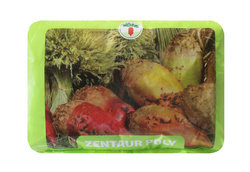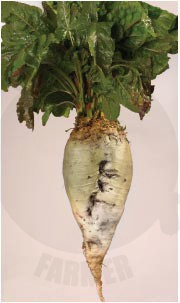- Odmiana wielokiełkowa, heterozyjna, poliploidalna. Korzeń owalny biały, płytka bruzda korzeniowa (zanieczyszczenie ziemią małe). Odporna na pośpiechy, tolerancyjna na choroby: cerkosporę, wirusa żółtaczki.
Odmiana wielokiełkowa, heterozyjna, poliploidalna. Korzeń owalny biały, płytka bruzda korzeniowa (zanieczyszczenie ziemią małe). Odporna na pośpiechy, tolerancyjna na choroby: cerkosporę, wirusa żółtaczki. Cechuje się bardzo wysoką zdrowotnością korzeni i liści, bardzo dobrze przechowuje się do późnej wiosny w temp od 0.5 do 4.00 C (małe straty do 2%). Odporna na suszę, przydatna na gleby słabsze. Zagłębienie w glebie (60%) umożliwia zbiór mechaniczny po uprzednim ogłowieniu z liści.
1 kg buraków zawiera łatwo przyswajalną sacharozę, 0.10 do 0.15 jednostki owsianej, 6–8 gram białka strawnego.
- Plon korzeni 1000 – 1100 q z ha
- % suchej masy 12,5 – 14,0 %
- Plon suchej masy 140 – 160 q z ha
- Plon liści 330 – 380 q z ha
- biały
- kwalifikowany w stopniu C1
ZALECENIA UPRAWOWE
Wymagania klimatyczno-glebowe
Ze względu na dużą odporność na pośpiechy, buraki pastewne mogą być uprawiane w chłodniejszych warunkach klimatycznych, tam gdzie uprawa kukurydzy jest niewskazana. Mogą być uprawiane na glebach IV i V klasy pod warunkiem głębokiej warstwy ornej z przepuszczalnym podłożem i niezakwaszonym.
Nawożenie
Mineralne:
- N – 100 do 150 kg/ha
- P2O5 – 80 do 120 kg/ha jesienią
- K2O – 150 do 200kg/ha jesienią
Siew
Normy wysiewu:
• dla odmian wielokiełkowych: 15-20 kg/ha
• dla odmian jednokiełkowych otoczkowanych: 4-6 kg/ha przy zdolności kiełkowania 85% i przy wysiewie docelowym 18-20 cm w rzędzie i rozstawie rzędów 42-45 cm
• dla odmian jednokiełkowych nieotoczkowanych: 3-5 kg/ha. Dobre plony przy minimalnej obsadzie 85 tys. roślin na 1 ha.
Redukcja zachwaszczenia
Walkę z zachwaszczeniem należy zacząć od profilaktyki, gdyż głównym źródłem chwastów są nasiona w glebie. Czynności zapobiegawcze i redukujące rozprzestrzenianie się chwastów to:
- staranny zbiór roślin przedplonowych (ograniczenie występowania samosiewów zbóż oraz rzepaku),
- utrzymanie czystości fitosanitarnej maszyn i narzędzi,
- niedopuszczenie do przenoszenia się chwastów z sąsiadujących pól uprawnych,
- stosowanie obornika z fermentacji na gorąco,
- płodozmian obejmujący uprawę gatunków roślin o zróżnicowanych wymaganiach agrotechnicznych (przemiennie zboża, okopowe, przemysłowe, warzywa) oraz roślin o właściwościach allelopatycznych takich jak żyto ozime, gryka, gorczyca biała, słonecznik, owies w międzyplonach,
- zabiegi agrotechniczne- podorywka, orka zimowa, uprawa przedsiewna,
- stosowanie mechanicznych sprzętów typu: pielniki szczotkowe, palcowe oraz szczotkowo-palcowe lub wąsowe,
- chemiczna ochrona według zaleceń IOR, efektywność herbicydów można podnieść poprzez stosowanie metody dawek dzielonych.
Choroby buraka popularne w Polsce: chwościk buraka, mączniak prawdziwy buraka, zgorzele siewek i zgnilizny korzeni; zwalczanie poprzez metody agrotechniczne, hodowlane i chemiczne zaprawianie oraz opryskiwanie roślin przy użyciu fungicydów.
Najważniejsze szkodniki buraka pastewnego: pędraki i drutowce, rolnice, mątwik burakowy, pchełka burakowa, drobnica burakowa, mszyca trzmielinowoburakowa, śmietka ćwiklanka, błyszczka jarzynówka.
Metody ograniczania: agrotechniczne oraz chemiczne poprzez stosowanie zapraw nasiennych oraz preparatów insektycydowych.








